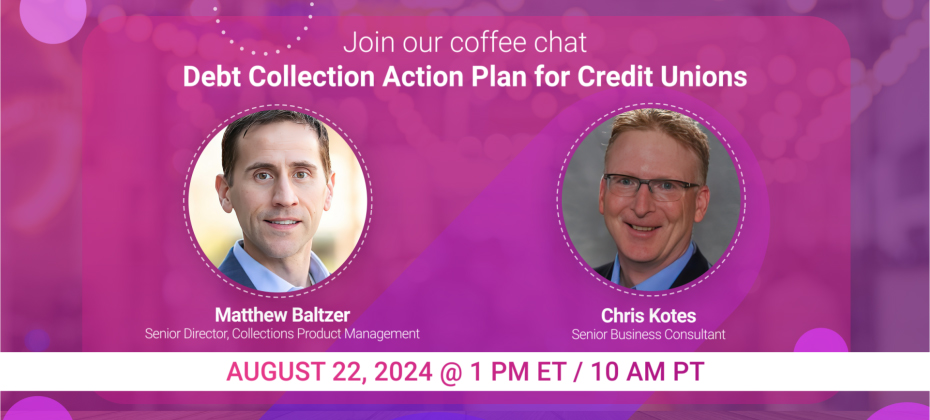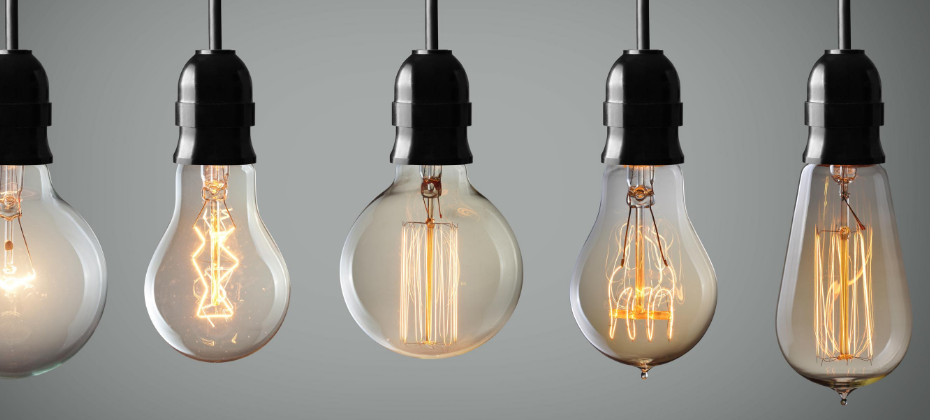Tag: collections best practices

With the noticeable uptick in delinquencies, credit unions face more significant hurdles in effectively managing overdue accounts. In this challenging financial landscape, it’s imperative that you refine your account management processes to remain competitive, preserve the well-being of your members, assure operational efficiency, and increase profitability. Implementing efficient collection approaches not only improves loss rates but also helps with member retention, which is the backbone of your success. Grab a cup of coffee and join our experts on August 22 @ 1:00 p.m. ET/ 10:00 a.m. PT, for an engaging conversation on credit union collection trends and successful account management strategies. Highlights include: Current landscape: Gain valuable insight and understanding into the current debt collection environment for credit unions. Navigating challenges: Discover effective tips and strategies to tackle obstacles in your business, improve loss rates, and enhance member retention. Real-time Q&A: Participate in a live Q&A session where our experts will address your questions. Watch on-demand

With rising consumer debt and an increasing number of consumers defaulting on loans, effective debt recovery strategies have never been more critical. Skip-tracing is the first-step in effective debt collection. This essential practice helps locate individuals who have become difficult to find, ensuring that you can recover outstanding debts efficiently. In this blog post, we'll explore skip-tracing best practices, offering valuable insights and practical tips and tools. Understanding and implementing these collection strategies can enhance your debt recovery efforts, improve overall efficiency, and increase your recovery rates. Understanding the importance of skip-tracing Skip-tracing is the process of locating individuals who have moved or otherwise become difficult to find. This technique is particularly important for financial institutions and debt collectors, enabling them to contact debtors and recover outstanding payments. Given the high stakes involved, mastering skip-tracing best practices is crucial for ensuring successful debt recovery. How to create an effective skip-tracing strategy 1. Use comprehensive skip-tracing data sources One of the foundational elements of an effective skip-tracing strategy is the use of comprehensive skip-tracing data sources. You can gather valuable information about a debtor's whereabouts by leveraging multiple databases, including public records, credit reports, and alternative data sources. The more data sources you utilize, the better chance of making right-party contact. 2. Prioritize data privacy While skip-tracing is essential for debt recovery, it's crucial to prioritize data privacy. Always adhere to the latest consumer contact debt collection regulations. This protects the individual's privacy and safeguards your organization from potential legal issues. 3. Stay updated with regulatory changes The regulatory landscape for debt collection and contacting consumers is constantly evolving. Staying updated with the latest changes ensures that your skip-tracing practices remain compliant with the law. Regularly review industry regulations, obtain proper consent from consumers and adjust your strategies accordingly. 4. Train your team Skip-tracing requires specialized skills and knowledge. Investing in regular training for your team ensures that they are equipped with the latest techniques and best practices. Offer workshops, webinars, and certification programs to keep your team up to date and improve their effectiveness. 5. Utilize skip-tracing software Skip-tracing software can significantly streamline the process and improve accuracy. Look for software solutions that offer comprehensive data integration, advanced search capabilities, and user-friendly interfaces. Implementing the right software can save time and resources while increasing right-party contact. 6. Monitor and evaluate performance Regularly monitoring and evaluating the performance of your skip-tracing efforts is essential for continuous improvement. Track key metrics such as right-party contact rates, time taken to locate individuals, contact method and cost. Use this data to identify areas for improvement and adjust your strategies accordingly. 7. Adapt to changing circumstances The world of debt management is dynamic, and circumstances can change rapidly. Be prepared to adapt your skip-tracing strategies to evolving situations. Whether it's changes in debtor behavior, new technology, or shifts in the regulatory landscape, staying flexible ensures that your skip-tracing efforts remain effective. Why choose Experian® for skip-tracing solutions Skip-tracing is a critical tool for financial institutions and debt collectors, enabling them to locate individuals and recover outstanding debts efficiently. Understanding and implementing collection best practices can improve your efforts and overall success rates. As a global leader in data and analytics, we offer extensive expertise and cutting-edge skip-tracing tools tailored to meet your unique needs. Comprehensive data integration: Our skip-tracing tools integrate data from multiple sources, including credit reports, alternative data, public records, and proprietary databases. This comprehensive approach ensures that you have access to accurate and up-to-date information, improving right-party contact. Recent and reliable data: While many data providers rely on static or stale data, our skip-tracing data is frequently updated, so you can avoid inaccurate, outdated information. More than 1.3 billion updates are made per month, including new phone numbers, new addresses, new employment, payment history, and more. Advanced technology: Our skip-tracing solutions leverage advanced technology, including AI and ML, to analyze data quickly and accurately. Our state-of-the-art algorithms identify patterns and connections to help you locate individuals more efficiently. Commitment to data privacy: We prioritize data privacy and adhere to the highest ethical standards. Our skip-tracing solutions are designed to protect personal information while ensuring compliance with industry regulations. You can trust us to handle data responsibly and ethically. Ready to take your skip-tracing efforts to the next level? Learn more Access white paper

Dealing with delinquent debt is a challenging yet crucial task, and when faced with economic uncertainties, the need for effective debt management and collections strategies becomes even more pressing. Thankfully, advanced analytics offers a promising solution. By leveraging data-driven insights, you can enhance operational efficiency, better prioritize accounts, and make more informed decisions. This article explores how advanced analytics can revolutionize debt collection and provides actionable strategies to implement treatment. Understanding advanced analytics in debt collection Advanced analytics involves using sophisticated techniques and tools to analyze complex datasets and extract valuable insights. In debt collection, advanced analytics can encompass various methodologies, including predictive modeling, machine learning (ML), data mining, and statistical analysis. Predictive modeling Predictive modeling leverages historical data to forecast future outcomes. By applying predictive models to debt collection, you can estimate each account's repayment likelihood. This helps prioritize your efforts toward accounts with a higher chance of recovery. Machine learning Machine learning algorithms can automatically identify patterns in large datasets, enabling more accurate predictions and classifications. For debt collectors, this means better segmenting delinquent accounts based on likelihood of repayment, risk, and customer behavior. Data mining Data mining involves exploring large datasets to unearth hidden patterns and correlations. In debt collection, data mining can reveal previously unnoticed trends and behaviors, allowing you to tailor your strategies accordingly. Statistical analysis Statistical methods help quantify relationships within data, providing a clearer picture of the factors influencing debt repayment and focusing on statistically significant repayment drivers, which aids in refining collection strategies. Benefits of advanced analytics in delinquent debt collection The benefits of employing advanced analytics in delinquent debt collection are multifaceted and valuable. By integrating these technologies, financial institutions can achieve greater efficiency, reduce operational costs, and improve recovery rates. Enhanced prioritization and decisioning With data and predictive analytics, you can gain a complete view of existing and potential customers to determine risk exposure and prioritize accounts effectively. By analyzing payment histories, credit scores, and other consumer behavior, you can enhance your collectoins prioritization strategies and focus on accounts more likely to pay or settle. This ensures that resources are allocated efficiently, and decisions are informed, maximizing your return on investment. Watch: In our recent tech showcase, learn how to harness the power of our industry-leading collection decisioning and optimization capabilities. Reduced costs Advanced analytics can significantly reduce operational costs by streamlining the collection process and targeting accounts with higher recovery potential. Automated processes and optimized resource allocation mean you can achieve more with less, ultimately increasing profitability. Better customer relationships With debt collection analytics, digital communication tools, artificial intelligence (AI), and ML processes, you can enhance your collections efforts to better engage with consumers and increase response rates. Adopting a more empathetic and customer-centric approach that embraces omnichannel collections can foster positive customer relationships. Implementing advanced analytics: A step-by-step guide Step 1: Data collection and integration The first step in implementing advanced analytics is to gather and integrate data from various sources. This includes payment histories, account information, demographic data, and external data such as credit scores. Ensuring data quality and consistency is crucial for accurate analysis. Step 2: Data analysis and modeling Once the data is collected, the next step is to apply advanced analytical techniques. This involves developing predictive models, training machine learning algorithms, and conducting statistical analyses to identify notable patterns and trends. Step 3: Strategy development Based on the insights gained from the analysis, you can develop targeted collection strategies. These may include segmenting accounts, prioritizing high-potential recoveries, and choosing the most effective communication methods. It’s essential to test and refine these strategies to ensure optimal performance continually. Step 4: Automation and implementation Implementing advanced analytics often involves automation. Workflow automation tools can streamline routine tasks, ensuring strategies are executed consistently and efficiently. Integrating these tools with existing debt collection systems can enhance overall effectiveness. Step 5: Monitoring and optimization Finally, continuously monitor the performance of your advanced analytics initiatives. Use key performance indicators (KPIs) to track success and identify areas for improvement. Regularly update models and strategies based on new data and evolving trends to maintain high recovery rates. Putting it all together Advanced analytics hold immense potential for transforming delinquent debt collection and can drive better return on investment. By leveraging predictive modeling, machine learning, data mining, and statistical analysis, financial institutions and debt collection agencies can perfect their collection best practices, prioritize accounts effectively, and make more informed decisions. Our debt collection analytics and recovery tools empower your organization to see the complete behavioral, demographic, and emerging view of customer portfolios through extensive data assets, advanced analytics, and platforms. As the financial landscape evolves, working with an expert to adopt advanced analytics will be critical for staying competitive and achieving sustainable success in debt collection. Learn more *This article includes content created by an AI language model and is intended to provide general information.

This article was updated on January 31, 2024. Debt. For many, it’s a struggle – and a constant one. In fact, total consumer debt balances have increased year-over-year.1 High inflation and fears of a recession aren't letting up either. Successful third-party debt collections can be achieved by investing in the right data and technologies. Overcoming debt collections challenges While third-party debt collectors may take a more specialized approach to collections, they face unique challenges. Debt collectors must find the debtor, get them to respond, collect payment, and stay compliant. With streamlined processes and enhanced strategies, lending institutions and collection agencies can recoup more costs. Embrace automationAutomation, artificial intelligence, and machine learning are at the forefront of the continued digital transformation within the world of collections. When implemented well, automation can ease pressure on call center agents and improve the customer experience. Automated systems can also help increase recovery rates while minimizing the risk of human error and the corresponding liability. READ: Three Tips for Successful Automated Debt CollectionsMaximize digitalizationIntegrating and expanding digital technologies is mandatory to be successful in the third-party debt collections space. Third-party debt collectors must be at the forefront of adopting digital communication tools (i.e., email, text, chatbots, and banking apps), to connect more easily with debtors and provide a frictionless customer experience. A digital debt recovery solution helps third-party debt collectors streamline processes, maintain debt collection compliance, and maximize collections efforts. READ: The Ultimate Guide to Successful Debt Collection TechniquesLeverage the best data Consumer data is ever-changing, especially during times of economic distress. Capturing accurate consumer information through a combination of data sources — and continually evaluating the data’s validity — is key to reducing risk throughout the consumer life cycle. By gaining a fresher, more complete view of existing and potential customers, third-party debt collectors can better determine an individual’s propensity to pay and enhance their overall decisioning. Keep pace with changing regulations With increasing scrutiny on the financial services industry and ever-evolving consumer protection and privacy regulations, remaining compliant is a top priority for third-party debt collections departments and agencies. The increased focus on regulations and compliance has also brought to the surface the need for teams to include debt collectors with soft skills who can communicate effectively with indebted consumers. With the right processes and third-party debt collections tools, you can better develop a robust compliance management strategy that works to prevent reputational risk and minimize costly violations. Finding the right debt collections partner In today's climate, it's never been more important to build the right third-party debt collections strategies for your business. By creating a more effective, consumer-focused collections process, you can maximize your recovery efforts, make more profitable decisions and focus your resources where they’re needed most. Our third-party debt management solutions empower your organization to see the complete behavioral, demographic, and emerging view of customer portfolios through extensive data assets, debt collection predictive analytics innovative platforms. For more insights to strengthen your debt collection strategy, download our tip sheet. Access tip sheet

Debt collectors need to find, contact and work with people to collect on unpaid accounts. That can be challenging enough. But when synthetic identity fraud accounts are mixed into your collection portfolio, you'll waste resources trying to collect from people who don't even exist. What is synthetic identity fraud? Synthetic identity fraud happens when fraudsters mix real and fake identity information — such as a stolen Social Security number (SSN) with a fake name and date of birth — to create an identity. Fraudsters occasionally try to quickly create and use synthetic IDs to commit fraud. But these are often more complex operations, and the fraudsters spend months or years building synthetic IDs. They might then use or sell an identity once it has a thick credit file, matching identification documents and a robust social media presence. The resulting fraud can have a significant impact on lenders. By some estimates, annual synthetic fraud losses for consumer loans and credit cards could be as high as $11 billion.1 Total annual losses are likely even higher because organizations may misclassify synthetic fraud losses — or not classify them at all — and fraudsters also target other types of organizations, such as business lenders and medical care providers Recognizing synthetic identities and fraud losses Organizations can ideally detect and stop synthetic IDs at account opening. If a fraudster slips past the first line of defense, fraud detection tools that aren't tailored for synthetic identity fraud might not flag the account as suspicious. This is especially true when fraudsters make several on-time payments, mirroring a legitimate account holder's behavior, before stopping payments or busting out. Sometimes, these past-due accounts get sent to collections before being written off as a credit loss. That creates new issues. Debt management and collections systems can help collections departments prioritize outreach and minimize charge-offs. But if you add fraudulent accounts to the mix, you wind up throwing away your time and resources. Even when you properly classify these written-off accounts as fraud losses, it can be hard to distinguish between first-party fraud by a legitimate consumer and synthetic identity fraud losses. However, the distinction can be important for optimizing your credit risk strategy. Detection is the key to prevention Keeping synthetic fraud out of collection portfolios requires a multi-layered approach to fraud management. You need systems to help stop synthetic fraud at the front door and ongoing account monitoring throughout the customer lifecycle. You also want fraud solutions that use data from multiple sources to recognize synthetic identities, such as credit bureau, public records, consortium and behavioral data. Experian's industry-leading fraud and identity solutions Experian's synthetic identity fraud and identity resolution solutions make it a leader in the space. These include: Sure Profile™uses credit, public record and identity-specific data to create a composite history of a consumer's identity and generate a risk score. You can automate risk-based decisions based on the score, and you'll have access to the underlying Sure Profile attributes. CrossCore® is a cloud-based identity and fraud management platform that you can connect to Experian, third-party and internal tools to get a 360-degree view of your accounts throughout the customer lifecycle. Experian partners with the Social Security Administration to offer an electronic Consent Based Social Security Number Verification (eCBSV) service, which can help you determine if an SSN, name and date of birth match. It can be an important part of a step-up verification when risk signals indicate that an identity might not be legitimate. View our tip sheet to learn more about keeping fraudulent accounts out of your collection portfolio. Download now 1Experian (2022). Preventing synthetic identity fraud

Consumer debt topped $17 trillion in the first quarter of 2023 — an increase of almost $3 trillion compared to 20191 — with challenging inflation levels, increases in consumer demand and low unemployment levels leading consumers to spend.2 A significant portion of mortgages, auto loans and leases, credit card debt and student loans aren't paid on time. Recent data reveals that 2.6 percent of accounts in the U.S. are delinquent1, with 175 million consumer credit reports showing past-due accounts.3 More debt means more pressure on collection agencies, requiring effective strategies to collect on delinquent accounts. Implementing effective debt collection strategies is especially crucial in the face of challenges like staff shortages, regulatory pressures and the declining success of outbound calling.4 The approach to successful debt collection has changed. Debt collectors and agencies that implement these debt collection techniques and debt recovery tools can improve their performance and bottom line. Debt collection techniques that work Leverage data Outdated approaches to collections ignore consumer contact preferences. Research shows that credit card customers with overdue balances prefer to be contacted via email or text (SMS) over phone calls. Among those with low credit scores and balances under $1,000, 56% preferred emails compared to 18% who preferred to be contacted about their delinquent debt over the phone.5 Data analytics allow you to segment customers based on the amount owed, payment histories, credit scores and past behaviors. This information makes it easier to target those most likely to repay their debt and offer personalized, pre-approved debt solutions. Customers with delinquent debt who preferred digital contact over traditional channels, like phone and mail, were up to 30% more likely to make a payment when debt collectors made contact through a digital channel.4 By leveraging data and analytics, you can create a contact management strategy that increases efficency and profitability. Embrace automation Using digital tools can help streamline the debt collection process. Automation, data, analytics and artificial intelligence (AI) make it easier to create customer profiles and enhance account prioritization.4 Incorporating self-service debt collection options is also essential. Customers want to learn about their options, set up their payment terms and repayment schedules and address their debt at a convenient time via their preferred platform. Digital approaches can be helpful when recovering payments on accounts that are more than 30 days overdue. Research shows that 73% of customers contacted via digital channels for overdue accounts made at least a partial payment compared with just 50% who were contacted via traditional channels.6 Overall, digital-first approaches have been linked to a 25% increase in the resolution of accounts that are more than 30 days past due, a 15% reduction in collections cost and customer engagement levels that are five times higher than traditional collections methods.7 Investments in automation and other digital tools are necessary to replace outdated methods of debt collection that don’t put customers first or place an extra burden on staff. Prioritize the customer experience Leveraging data for customer segmentation is not the only way debt collectors can increase recovery rates. Delivering personalized debt solutions that are proactive, fair and customer-focused is also essential to achieving higher recovery returns.5 Predictive analytics provide insight into customer behavior, making it easier to identify those who need additional support and allowing debt collectors to be responsive to their needs.5 Collections used to be a linear process, but with customer migration to digital — with 64% of consumers using more than four devices per day — collectors need to rethink their approach.8 Consumers expect convenient interactions and relevant communications. Debt collectors that prioritize omnichannel communications can make debt repayment more convenient, resulting in improved customer retention. Remain compliant Digital tools have made it easier for debt collectors to connect with consumers, but legal compliance is still essential. In 2021, the Consumer Finance Protection Bureau (CFPB) passed Regulation F (Reg F) to govern electronic communications for debt collections. The regulations state that electronic communication, including email, text messages and social media, are allowed with direct consent from the consumer; limits on call frequencies do not apply to electronic communications but contacting consumers at inconvenient times and general harassment are still prohibited. Opt-out notices that are clear and prominent are required in all electronic communications.9 Predictive analytics and process automation can also play a role in minimizing regulatory risk by reducing gaps in the contact strategy and helping debt collectors avoid fines. Debt collectors face significant challenges in recovering delinquent debt. A digital-first strategy that prioritizes the customer experience while remaining compliant is essential. Why partner with Experian Increased automation, self-service processes and individualized approaches allow you to focus on accounts with the greatest recovery potential while minimizing charge-offs and ensuring compliance. Implementing an efficient and effective collections prioritization strategy can require a lot of work, but you don’t have to go at it alone. Experian offers various debt collection solutions that can help optimize processes and free up your organization’s resources and agents’ time. Learn more about our debt collection techniques 1Federal Reserve Bank of New York. “Quarterly Report on Household Debt and Credit." 2Experian. “Average Consumer Debt Levels Increase in 2022."Published February 24, 2023. Accessed July 31, 2023.3Consumer Financial Protection Bureau. “Market Snapshot: An Update on Third-Party Debt Collections Tradelines Reporting.” Published February 2023. Accessed July 31, 2023.4McKinsey & Company. “Going digital in collections to improve resilience against credit losses.” Published April 29, 2019. Accessed July 31, 2023.5EY. “Five ways banks can transform their collections processes.” Published November 19, 2020. Accessed July 31, 2023.6McKinsey & Company. “The customer mandate to digitize collections strategies." Published July 29, 2019. Accessed July 31, 2023.7McKinsey & Company. “Holistic customer assistance through digital-first collection.” Published May 21, 2021. Accessed July 31, 2023.8Consumer Finance Protection Bureau. “1006.6 Communications in connection with debt collection." Published November 30, 2021. Accessed July 31, 2023

This article was updated on August 9, 2023. Debt collections can be frustrating — for both consumers and lenders alike. Coupled with ever-changing market conditions and evolving consumer expectations for their digital experience, lending institutions and collections agencies must develop the right collections strategies to reduce costs and maximize recovery rates. How can they do this? By following the three Cs — communication, choice and control. Communication To increase response rates and successfully retrieve payments, lenders must cater to consumers’ preferences for communication, or more specifically, make the right type of contact at the right time. With debt collection predictive analytics, you can gain a more holistic view of consumers and further insight into their behavioral and contact channel preferences. This way, you can better assess an individual's propensity to pay, determine the best way and time to reach them and develop more personalized treatment strategies. Control Debt collection solutions that provide a more comprehensive customer view can also give individuals greater control as they’re able to engage with collectors via a channel that may be easier or more comfortable for them than a phone call, such as email, text or chatbots. Providing consumers with various options is especially important as 81% think more highly of brands who offer multiple digital touchpoints. To further improve your methods of communication, consider streamlining monotonous processes with collection optimization. By automating repetitive tasks and outreach, you can reduce errors and free up your agents’ time to focus on accounts that need more attention, creating a customer-centric collections experience. Choice Ultimately, the success of collections initiatives relies heavily on how well collection practices are accepted and adopted by the end user. Consumers want to make informed decisions and want to be offered choices – therefore giving them more control in a decision-making process and with their finances. “Consumers have made a monumental shift to digital. To enhance your collections performance, it is critical to engage consumers in the method and channel of their choosing,” said Paul Desaulniers, Head of Scoring, Alternative Data and Collections at Experian. Lending institutions and third-party collection agencies that are able to communicate across all consumer channels will see more success in their collections strategies. Are your debt collection tactics and strategies up-to-par? READ: Strengthening Your Debt Collection Strategy Improve your collections strategy By catering to consumers’ communication preferences, giving them control and offering them choices, financial institutions and collections agencies can more effectively reach their customer base, with less effort. It’s a win-win for all. Experian offers various debt management and collections systems that can help you optimize processes, reduce costs and increase recovery rates. To get started, visit us today. Learn more

Breaking down, rethinking, and optimizing your debt collection recovery process can be complicated — but you risk falling behind if you don't invest in your business. From managing live agents to unlocking the latest machine-learning models, there are different options and routes you can take to improve recovery rates. Debt collection challenges in 2023 Collection agencies have embraced digitization. The benefits are numerous — cost savings, streamlined processes, and improved compliance, to name a few. However, digital tools aren't cure-alls, and they can even create new challenges if you're not careful. Maintaining accurate consumer data: Quickly reaching consumers can be difficult during times of economic uncertainty. Increased access to data can help you overcome this challenge, but only if you can manage and understand the information. If you simply turn on the metaphorical data streams, you could find yourself drowning in duplicate and erroneous entries.Keeping up with rising delinquencies: Delinquency rates steadily rose throughout 2022.1 Although rates may level out for some types of accounts in 2023, collection agencies need a plan for dealing with the potential increased volume. At the same time, continued low unemployment rates could make it difficult to hire and retain agents. Managing a tight budget: Recession worries also have companies rethinking expenses, which can impact your ability to increase head count and invest in technology. Finding effective trade-offs is going to be important for debt collection process optimization.Staying compliant: We've seen some major changes over the last few years, but there's no time to rest — debt collectors always need to be aware of new state and federal regulations. Digitization might make compliance more difficult if you're now managing an increasing amount of personal information or using text messages (or other omni-channels) to contact consumers. WATCH:Keeping pace with collections compliance changes Five ways to enhance your debt collection process Here are five ways that debt collectors can overcome today's challenges and take advantage of new opportunities. 1. Leverage clean data Continuously updating and checking the accuracy of your data can help increase right-party contact rates. But don't rely on your internal data and basic internet searches or public records. Leading data and skip-tracing services can give you access to additional data from credit bureaus, alternative financial services, collateral records, business listings and other helpful sources. Some skip-tracing tools can continuously verify and update contact information. They can also rank contact records, such as phone numbers, to save your agent's time. And identify consumers in a protected status such as bankrupt, deceased, and active military) and require special handling to help you stay compliant. 2. Implement advanced analytics and automation High-quality data can also be the foundation for a data-driven approach to collections. Use collections-specific models: Although credit risk scores can be a piece of the debt collection puzzle, debt collection recovery models are often a better fit. You may be able to use different models to score accounts based on exposure, risk, willingness to pay or behavioral factors. Segment accounts: Increased insights and models also allow you to more precisely segment accounts, which can help you handle larger volumes with fewer resources. For instance, you can more accurately determine which accounts require an agent's personal touch, which can move forward with an automated experience and which should go to the back of your queue. The data-driven approach also allows you to increasingly automate your collections — which can help you deal with rising delinquency rates in the face of a tight labor market and budget constraints. 3. Know when and how to make contact Segmentation and advanced analytics can tell you who and when to contact, but you also have to be mindful of how you reach out. Letters, calls, emails and texts can all be effective in the right circumstances, but no single option will always be best. For example, a text could be ideal when contacting Gen Z, but a call might work best for Baby Boomers. That's neither novel nor surprising, but it is important to stay up to date with the latest trends and preferences. Ideally, you reach people on their preferred channel at an appropriate time. You may also need to continually test, monitor and refine your process, especially if you want to increase automation. READ:Digital Debt Collection Future white paper 4. Offer financially appropriate treatments In addition to picking the right communication channel, consider the payment options you offer consumers. Various payment plans, settlements and policies can directly affect your recovery rates — and what performed best in previous years might not make sense anymore. Chatbots and virtual negotiators can also help improve recovery rates without straining your agents' time. And for accounts that will likely self-cure, automated texts or emails with links to self-service portals could be an ideal solution. Expanding payment methods, such as accepting payments from digital wallets when you're sending a text message, could also make sense. However, you want to be sure you're not wasting time or money by contacting consumers who don't have the means to make a payment. Instead, set those accounts aside for now, but monitor them for changes that could indicate their financial situation has changed — such as a new credit line. Then, try to offer a solution that will likely fit the consumer's circumstances. 5. Invest in your live agents Modern debt management and collection systems focus on digitization and automation, and these can improve recovery rates. But don't forget about your front-line agents. There will always be times when a personal touch gets you further than an automated message. Continued training and ongoing recognition can be important for retaining top performers, maintaining compliance and increasing agents' effectiveness. Partner for success Implementing an efficient and effective collections strategy can require a lot of work, but you don't have to go at it alone. Experian offers various debt collection solutions that can help optimize processes and free up your organization's resources and agents' time. Tap into our industry-leading data sources — including traditional credit data, alternative financial data and over 5,000 local phone exchange carriers — to find, update and verify account information. Available on the cloud or with secure file transfers, the TrueTrace™ and TrueTrace Live™ tools have led to a 10 percent lift in right-party contact rates compared to competitors. When it comes to optimizing outreach, you can prioritize accounts with over 60 industry-specific debt recovery scores via PriorityScore for CollectionsSM. Or work with Experian to create custom models for your organization. For an end-to-end decisioning solution, our AI-driven PowerCurve® Collections solution draws from internal and external data to determine the proper customer contact frequency, channel and treatment options, including self-service portals. Create your own strategies and workflows and manage the entire process with a single dashboard, cloud-based access and integrated reports. Learn more about Experian's debt collection process solutions 1Experian. (February 2023). Credit Scores Steady as Consumer Debt Balances Rise in 2022

It's easy to ignore a phone call—especially from an unknown number—or delete an email without looking past the subject line. Even physical letters get thrown out without being opened. But nearly everyone will quickly open and read a text. Surveys have repeatedly found text message open rates can range from around 90 to 98 percent. And now, debt collectors that are serious about streamlining operations and connecting with consumers via their preferred channel can integrate text messaging into their process. Learn more Using text messages in debt collection It's been a couple of years since the Consumer Financial Protection Bureau (CFPB) revised Regulation F, which implements the Fair Debt Collection Practices Act (FDCPA). The ruling was effective starting November 2021 and confirmed that debt collectors could use emails, text messages and other digital communication channels. Businesses in many other industries have been communicating with customers by text for years. At a high level, the changes to Regulation F allow debt collectors to add new outreach methods to their debt collection tools. However, even with the go-ahead to communicate via text, strategy and compliance must be top of mind. WATCH: Webinar: Keeping pace with collections compliance changes The move to digital debt collections Incorporating text messaging could be part of a larger shift toward digitizing operations. Some debt collection agencies are also using artificial intelligence, big data and automation to help verify consumers' contact information, assist call center agents and follow up with consumers. As the Experian 2022 Global Insights Report reports, 81 percent of consumers think more highly of brands if they have a positive online experience with that brand that involves multiple digital touchpoints. And over half of consumers trust organizations that use AI.1 Your website or mobile app is an important starting point. And digital tools, such as chatbots that can answer common questions and virtual negotiators offering payment plans, could be part of that experience. Your automated and manual text message outreach could also be increasingly important in the coming years. The benefits of debt collection text messages A text message strategy can be part of an omnichannel approach, and it offers debt collectors a few distinct benefits: Get direct access to consumers who will likely see and read your messages. Allow consumers to respond and ask questions via a channel that may be easier or more comfortable for them than a phone call. Start a two-way dialogue and build rapport. Save time by texting multiple consumers simultaneously and automating responses to common questions. However, collection agencies also need to beware of the potential drawbacks. Consumers might see your texts as a nuisance if you frequently send messages or if you're messaging people who truly can't afford a payment right now. Many consumers are also rightly wary of scammers texting them and asking them to click on a link. You'll want to carefully think through your messaging strategy. Starting by getting consent to send a text message while you're on the phone or when the consumer fills out a form online—and then immediately sending a text with an opt-in—can help overcome this potential barrier. How to leverage debt collection text messages Sending payment requests via text to consumers who have a high propensity to repay, and including a link to self-service payment portals, could offer a quick and easy win. However, it may be best to think through how you'll use text messaging to optimize your outreach rather than replace other communication channels. WATCH: Webinar: Adapting to the new collections landscape Perhaps you've spoken directly with someone and helped them set up a payment plan. You could now use automated texts to remind them of upcoming payment due dates and thank them for their payments. It's a simple way to test the water without sending debt collection-related messages that may fall under stricter regulatory requirements. Staying compliant while texting As part of a highly regulated industry, debt collection agencies must consider compliance. And it's especially important to consider when trying new technology that directly interacts with consumers. Laws and rulings may change, and it's important to consult your counsel before making any decisions or implementing a text message strategy. However, at a high level, the Regulation F requires debt collectors to: Prioritize capturing consent.You must obtain direct consent from a consumer or indirect consent from an original creditor that got the consumer's consent. The initial communication before sending a text or email must be written. Debt collectors that use specific procedures for obtaining consent may receive safe harbor protections against inadvertent disclosures to third parties. Make opting out easy. You must send consumers a clear and conspicuous opt-out notice and offer them a reasonable and simple method to opt out of text messaging or other electronic communications. Debt collectors must identify when they receive an opt-out request, even if the request doesn't follow their specific instructions. For example, if a consumer sends “end," you may need to recognize that as an opt-out even if your opt-out instructions tell them to send “stop." Continue complying with FDCPA harassment guidelines. There's no specific federal limit on how often you can text consumers. However, you'll still need to comply with the FDCPA's general rules regarding harassment and contacting consumers at convenient times. In general, you may want to send texts between 8 a.m. and 9 p.m. local time (for the consumer), unless they request a different time. Limiting how many texts you send can also improve consumers' experiences and may lead to better long-term results. Reconfirm consent every 60 days. Even if consumers don't opt out, the implied or expressed consent you received could only be valid for 60 days. To continue texting a consumer, you may need to have them reconfirm their consent or use a complete and accurate database to confirm that their phone number was not reassigned.2 You may also be subject to more stringent state or local laws. For instance, Washington State laws might prohibit debt collectors from sending more than two texts in a day.3 And Washington, D.C. forbids debt collectors from initiating communications with consumers via written or electronic communications (including text messages) during and for at least 60 days following a public health emergency. READ: A Digital Debt Collection Future: Maximizing Collections and Staying Compliant Partnering with Experian Experian offers access to vast data sources, skip tracing tools for collections and advanced analytical capabilities that help debt collectors move into the digital age. From optimizing outreach with the AI-driven PowerCurve® Collection to verifying real-time phone ownership using Phone Number ID™ with Contact Monitor™, you can integrate the latest technology while remaining compliant. You can then decide the best ways to use text messages, or other electronic communication methods, to make profitable decisions and maximize recovery rates. Learn more about Experian's debt collection solutions. ¹Experian. (April 2022). Experian 2022 Global Insights Report ²Consumer Financial Protection Bureau. (2023). 1006.6 Communications in connection with debt collection. ³Washington State Legislator. (2023). RCW 19.16.250 Prohibited practices

As economic conditions shift and consumer behavior fluctuates, first- and third-party debt collectors must adapt to continually maintain effective debt collection strategies. In this article, we explore collections best practices that can empower collectors to improve operational efficiency, better prioritize accounts and enhance customer interactions, all while ensuring compliance with changing regulations. Best practices for improving your collection efforts 1. Implement a data-driven collection strategy Many collectors are already using artificial intelligence (AI) and machine learning (ML) to gain a more complete view of their consumers, segment accounts and create data-driven prioritization strategies. The data-backed approach is clearly a trend that's going to stick. But access to better (i.e., more robust and hygienic) data and debt collection analytics will distinguish the top performers.You can use traditional credit data, alternative credit data, third-party data and advanced analytics to more precisely segment consumers based on their behavior and financial situation — and to determine their propensity to pay. Supplementary data sources can also help with verifying consumers' current contact information and improving your right-party contact rates.Cloud-based platforms and access to various data sources give debt collectors real-time insights. Quickly identifying consumers who may be stretched thin or trending in the wrong direction allows you to proactively reach out with an appropriate pre-collection plan.And for consumers who are already delinquent, the more precise segmentation and tracking can help you determine the best contact channels, times and personalized treatments. For instance, you could optimize outreach based on specific account details (rather than general time-based metrics) and offer payment plans that the customer can likely afford. 2. Use technology to maximize your resources Data-driven prioritization strategies can help you determine who to contact, how to contact them and the treatment options you offer. But you may need to invest in technology to efficiently execute these findings. Although budgets may be limited, the investment in debt recovery tools can be important for handling rising account volumes without increasing headcount. Some opportunities include: Automate processes and outreach: Look for opportunities to automate tasks, particularly monotonous tasks, to reduce errors and free up your agents' time to focus on more valuable work. You could also use automated messages, texts, chatbots and virtual negotiators with consumers who will likely respond well to these types of outreaches. Establish self-service platforms: Create self-service platforms that give consumers the ability to choose how and when to make a payment. This can be especially effective when you can accurately segment consumers based on the likelihood that they'll self-cure and then automate your outreach to that segment. Keep consumer data up to date: Have systems in place that will automatically verify and update consumers' contact information, preferences and previous collection attempts. Reprioritize old accounts based on significant changes: Tools like Experian's Collection Triggers℠ allow you to monitor accounts and automatically get alerted when consumers experience a significant change, such as a new job, that could prompt you to put their account back into your queue. 3. Prioritize customer experience In some ways, debt collectors today often work like marketers by embracing digital debt collection and a customer-first philosophy to improve the consumers' experiences. Your investment in technology goes together with this approach. You'll be able to better predict and track consumers' preferences and offer self-cure options for people who don't want to speak directly with an agent. You also may need to review your regular onboarding and training programs. Teaching your call center agents to use empathy-based communication techniques and work as a partner with consumers to find a viable payment plan can take time. But the approach can help you build trust and improve customer lifetime value. 4. Continue to carefully monitor regulatory requirements Keeping up with regulatory requirements is a perennial necessity for collectors, and you'll need to consider how to stay compliant while adding new communications channels and storing consumer data. For example, make sure there are “clear and conspicuous" opt-out notices in your electronic communications and that your systems can track which channels consumers opt out of and their electronic addresses.1In some cases, the customer-first approach may help minimize regulatory risks, as you'll be training agents to listen to consumers and act in their interest. Similarly, data-driven optimizations can help you increase collections with fewer contacts.WATCH: Explore credit union collection trends and successful account management strategies. Partner with a top provider to achieve success Experian has partnered with many debt collectors to help them overcome challenges and increase recovery rates. There are multiple solutions available that you can use to improve your workflow: TrueTrace™ and TrueTrace Live™: Leverage access to the consumer credit database that has information on over 245 million consumers, and additional alternative databases, to maintain current addresses and phone numbers. PriorityScore for Collections ℠ Know which accounts you should focus on with over 60 industry-specific debt recovery scores. You can choose to prioritize based on likelihood to pay or expected recovery amount. Collection Triggers℠: Daily customer monitoring can tell you when it's time to approach a consumer based on life events, such as new employment or recent credit inquiries. Phone Number ID™ with Contact Monitor™: Increase right-party contact rates and avoid Telephone Consumer Protection Act (TCPA) violations with real-time phone ownership and type monitoring from over 5,000 local exchange carriers. Experian's PowerCurve® Collections and Experian® Optimize solutions also make AI-driven automated systems accessible to debt collectors that previously couldn't afford such advanced capabilities. Building on Experian's access to many sources of credit and non-credit data, these solutions can help you design debt collection strategies, predict consumer behavior and automate decisioning.Learn more about Experian's debt collection solutions. Learn more This article includes content created by an AI language model and is intended to provide general information.

The collections landscape is changing as a result of new and upcoming legislation and increased expectations from consumers. Because of this, businesses are looking to create more effective, consumer-focused collections processes while remaining within regulatory guidelines. Our latest tip sheet has insights that can help businesses and agencies optimize their collections efforts and remain compliant, including: Start with the best data Keep pace with changing regulations Focus on agility Pick the right partner Download the tip sheet to learn how to maximize your collections efforts while reducing costs, avoiding reputational damage and fines, and improving overall engagement. Download tip sheet

Achieving collection results within the subprime population was challenging enough before the current COVID-19 pandemic and will likely become more difficult now that the protections of the Coronavirus Aid, Relief, and Economic Security (CARES) Act have expired. To improve results within the subprime space, lenders need to have a well-established pre-delinquent contact optimization approach. While debt collection often elicits mixed feelings in consumers, it’s important to remember that lenders share the same goal of settling owed debts as quickly as possible, or better yet, avoiding collections altogether. The subprime lending population requires a distinct and nuanced approach. Often, this group includes consumers that are either new to credit as well as consumers that have fallen delinquent in the past suggesting more credit education, communication and support would be beneficial. Communication with subprime consumers should take place before their account is in arrears and be viewed as a “friendly reminder” rather than collection communication. This approach has several benefits, including: The communication is perceived as non-threatening, as it’s a simple notice of an upcoming payment. Subprime consumers often appreciate the reminder, as they have likely had difficulty qualifying for financing in the past and want to improve their credit score. It allows for confirmation of a consumer’s contact information (mainly their mobile number), so lenders can collect faster while reducing expenses and mitigating risk. When executed correctly, it would facilitate the resolution of any issues associated with the delivery of product or billing by offering a communication touchpoint. Additionally, touchpoints offer an opportunity to educate consumers on the importance of maintaining their credit. Customer segmentation is critical, as the way lenders approach the subprime population may not be perceived as positively with other borrowers. To enhance targeting efforts, lenders should leverage both internal and external attributes. Internal payment patterns can provide a more comprehensive view of how a customer manages their account. External bureau scores, like the VantageScore® credit score, and attribute sets that provide valuable insights into credit usage patterns, can significantly improve targeting. Additionally, the execution of the strategy in a test vs. control design, with progression to successive champion vs. challenger designs is critical to success and improved performance. Execution of the strategy should also be tested using various communication channels, including digital. From an efficiency standpoint, text and phone calls leveraging pre-recorded messages work well. If a consumer wishes to participate in settling their debt, they should be presented with self-service options. Another alternative is to leverage live operators, who can help with an uptick in collection activity. Testing different tranches of accounts based on segmentation criteria with the type of channel leveraged can significantly improve results, lower costs and increase customer retention. Learn About Trended Attributes Learn About Premier Attributes

New challenges created by the COVID-19 pandemic have made it imperative for utility providers to adapt strategies and processes that preserve positive customer relationships while continuing to collect delinquent balances during an unpredictable and unprecedented time. As part of our ongoing Q&A perspective series, Beth Bayer, Experian’s Vice President of Energy Sales, and Danielle Grigaliunas, Product Manager of Collection Solutions, discuss the changing collections landscape and how the utility industry can best adapt. Check out what they had to say: Q: How are the COVID-19 crisis and today’s economic environment impacting consumer behavior? Particularly as it relates to delinquencies and payments? BB: Typically, when we experience recessions, delinquency goes up. In this recession, delinquency is declining. Stimulus money and increased unemployment benefits, coupled with stay at home orders, appear to be leading to more dollars available for consumers to repay obligations and debts. Another factor is related to special accommodations, forbearances, and payment holidays or extensions, that provide consumers with flexible options in making their regularly scheduled payments. Once an accommodation is granted, the lender or bank puts a code on the account when it’s reported to the bureaus and the account does not continue to age. Q: As a result of the pandemic, many regulatory bodies are recommending or imposing changes to involuntary disconnect policies. How can utility providers effectively collect, even if they can’t disconnect? BB: The public utility commissions in many areas have suspended disconnects due to non-payment, further increasing balances, delinquency and delaying final bill generation. Without the fear of being disconnected for non-payment in some regions of the country, customers are not paying delinquent utility bills. Utility providers should continue to provide payment reminders and delinquency notices and offer payment plans in exchange for partial payments to continue to engage customers. Identifying which customers can pay and are actively paying other creditors and institutions helps prioritize proactive outreach. Q: For utility providers who offer in-house collection services, what strategies and credit data do you find most valuable? DG: Current and accurate data is key when looking to provide stronger and more strategic collections. This data is built into efficient scoring models to articulate which debts are most collectible and how much money will be recovered from each consumer. Without the overlay of credit data, it’s harder for utility providers to predict how consumers prioritize utility debt during times of economic stress. By better understanding the current state of the consumer, utility providers can focus on consumers who are most likely to pay. Investing in monitoring solutions allows utility providers to receive notifications when their consumers are beginning to cure and pay off other obligations and take a more proactive approach. Q: What are the best methods for utility providers to reach collection consumers? What do they need to know as they begin to utilize omnichannel communications? DG: Regular data hygiene checks and skipping are the first line of defense in collections. Confirming contact information is correct and up to date throughout the entire consumer lifecycle helps to establish a strong relationship. Those who are successful in collections invest in omnichannel messaging and self-service payment options, so consumers have a choice on how they’d like to settle their obligations. Q: What current collection trends/challenges are we seeing within the utility space? BB: Utility providers do not traditionally report active customer payments and delinquencies to the credit bureaus. Anecdotally, our utility partners tell us that delinquencies are up and balances are growing. Many customers know that they cannot currently be disconnected if they fall behind on their utility payments and are using this opportunity to prioritize other debts. We also know that some utilities have reduced collection activities during the pandemic due to office closures and have cut back on communication efforts. Additionally, we’re hearing from some of our utility partners that collections and recoveries of final billed or charged-off accounts are increasing, despite many agencies closing and limited to no collection activities occurring. We assume this is because these balances are typically reported to the credit reporting agencies, triggering a payment and interest in clearing that balance first. Constant communication, flexibility, and empathizing with your customers by offering payment plans and accommodations will lead to an increase in dollars collected. DG: There’s been a large misunderstanding that because utility providers can’t disconnect, they can’t attempt to collect. The success of collections has been seen within first parties, as they are still maintaining strong relationships by reaching out at optical times and remaining top-of-mind with consumers. The utility industry needs to take a proactive approach to ensure they are focusing on the right consumers through the right channels at the right time. Credit data that matches the consumer’s credit health (i.e. credit usage and payments) is needed insight when trying to understand a consumer’s overall financial standing. For more insight on how to enhance your collection processes and capabilities, watch our Experian Symposium Series event on-demand. Watch now About our Experts: Beth Bayer, Vice President of Sales, Experian Energy, North America Beth leads the Energy Vertical at Experian, supporting regulated, deregulated and alternative energy companies throughout the United States. She strives to bring innovative solutions to her clients by leveraging technology, data and advanced analytics across the customer lifecycle, from credit risk and identity verification through collections. Danielle Grigaliunas, Product Manager of Collections Solutions, Experian Consumer Information Services, North America Danielle has dedicated her career to the collections space and has spent the last five years with Experian, enhancing and developing collections solutions for various industries and debt stages. Danielle’s focus is ensuring that clients have efficient, compliant and innovative collection and contact strategies.

The COVID-19 pandemic has created unprecedented challenges for the utilities industry. This includes the need to plan for – and be prepared to respond to – changing behaviors and a sudden uptick in collections activities. As part of our recently launched Q&A perspective series, Mark Soffietti, Experian’s Senior Manager of Analytics Consulting and Tom Hanson, Senior Energy Consultant, provided insight on how utility providers can evolve and refine their collections and recovery processes. Check out what they had to say: Q: How has COVID-19 impacted payment behavior and debt collections? TH: Consumer payment behavior is changing. For example, those who paid as agreed, may not currently have the means to pay and are now distressed borrowers. Or those who were sloppy payers before the pandemic may now be defaulting on a more consistent basis. MS: As we saw with the last recession when faced with economic stress, consumer and commercial payment behavior changes based on their needs and current cash flow. For example, people prioritize their car, as they need it to get to and from work, so they’ll likely pay their auto bills on time. The same goes for their credit cards, which they need to make ends meet. We expect this will also be true with COVID-19. The commercial segment will face more dramatic and challenging circumstances, where complete or partial business closures and lack of federal relief could have severe ramifications. Q: What new restrictions have been put in place surrounding debt collection efforts and outbound calls? TH: To protect consumers who may be experiencing financial distress, most states have imposed new, stringent restrictions to prevent utilities from engaging in certain collections activities. Utilities are currently not charging any late payment fees and are instead structuring payment plans. Additionally, all outbound collections efforts have been suspended and there is fieldwork being executed of services for both commercial and consumer properties. As of now, consumer and commercial fieldwork will likely not commence until after the first year or when the winter moratorium concludes. MS: The new restrictions imposed upon collections activities will likely drive consumer payment behavior. If consumers know that their utilities (i.e. energy and water) will not be shut off if they miss a payment, they will make these bills less of a priority. This will dramatically increase the amount owed when these restrictions are lifted next year. Q: Can we predict how the utilities industry will fare post-COVID-19? TH: The volume of accounts in collections and eligible for disconnect will be overwhelming. Many utility providers fear the unpaid balances consumers and commercial entities accumulate will be nearly impossible to fit into a repayment schedule. Both analyzing internal payment segments and overlaying external factors may be the best way to optimize the most critical go-forward plan. MS: The amount of people who fall into collections is going to greatly increase and utility providers need to start planning for it now to weather the storm. They will need to use data, analytics and tools to help them optimize their tasks, so they can be more efficient with their resources. Like many other industries, the utilities sector will look to increasing digitalization of their processes and having less social interaction where possible. This could mean the need and drive for expediting current smart meter programs where possible to enable remote fieldwork to assist in managing this unprecedented level of activity that is sure to overwhelm field operations (where allowed by state regulators). Q: What should utility providers be doing to plan for an uptick in collections activities post-COVID-19? TH: With regulatory mandated suspensions of collections activities for utility providers and self-selected reductions due to stay at home orders and staff protection, the backlog of payments, calls and inquiries once business resumes as normal is set to overwhelm existing capacity. More than ever, self-service options (text/web), Q&A and alternative communication methods will be needed to shepherd consumers through the collections process and minimize the strain on call center agents. Many utility providers are asking for external data points to segment their consumers by industry or by those whose employment would have been adversely impacted by COVID-19. MS: Utility providers should be monitoring consumer data in order to prepare for when they are able to collect. This will help them strategize the number of resources they will need in their call centers and out in the field performing shut off activities. Given that the rise in cases will be more volume than their call centers can handle, they will need to use their resources wisely and plan to use them efficiently when they are able to resume collections. Q: How can Experian help utility providers reduce collections costs and maximize recovery? TH: Experian can help revise collections tactics and segmentation strategies by providing insight on how consumers are paying other creditors and identifying new segmentation opportunities as we emerge from the freeze on collections activities. Collections cases will be complex, and many factors and constraints will need to balanced against changing goals, making optimization key. MS: Utilizing Experian’s credit data and models can help ensure that resources are being used efficiently (i.e. making successful calls). There is also a need to leverage ability to pay models as well as prioritization models. By using these models and tools, utility providers can optimize their treatment strategies, reduce costs and maximize dollars collected. Learn more About our Experts: Tom Hanson, Senior Energy Consultant, Experian CEM, North America Tom is a Senior Consultant within the Energy Vertical at Experian, supporting regulated energy companies throughout the U.S. He brings over 25 years of experience in the energy field and supports his clients throughout the customer lifecycle, providing expertise in ID verification, account treatment, fraud solutions, analytics, consulting and final bill/field optimization strategies and techniques. Mark Soffietti, Analytics Consulting Senior Manager, Experian Decision Analytics, North America Mark has over 15 years of experience transforming data into actionable knowledge for effective decision management. Mark’s expertise includes solution development for consumer and commercial lending across the credit spectrum – from marketing to collections.

The fact that the last recession started right as smartphones were introduced to the world gives some perspective into how technology has changed over the past decade. Organizations need to leverage the same technological advancements, such as artificial intelligence and machine learning, to improve their collections strategies. These advanced analytics platforms and technologies can be used to gauge customer preferences, as well as automate the collections process. When faced with higher volumes of delinquent loans, some organizations rapidly hire inexperienced staff. With new analytical advancements, organizations can reduce overhead and maintain compliance through the collections process. Additionally, advanced analytics and technology can help manage customers throughout the customer life cycle. Let’s explore further: Why use advanced analytics in collections? Collections strategies demand diverse approaches, which is where analytics-based strategies and collections models come into play. As each customer and situation differs, machine learning techniques and constraint-based optimization can open doors for your organization. By rethinking collections outreach beyond static classifications (such as the stage of account delinquency) and instead prioritizing accounts most likely to respond to each collections treatment, you can create an improved collections experience. How does collections analytics empower your customers? Customer engagement, carefully considered, perhaps comprises the most critical aspect of a collections program—especially given historical perceptions of the collections process. Experian recently analyzed the impact of traditional collections methods and found that three percent of card portfolios closed their accounts after paying their balances in full. And 75 percent of those closures occurred shortly after the account became current. Under traditional methods, a bank may collect outstanding debt but will probably miss out on long-term customer loyalty and future revenue opportunities. Only effective technology, modeling and analytics can move us from a linear collections approach towards a more customer-focused treatment while controlling costs and meeting other business objectives. Advanced analytics and machine learning represent the most important advances in collections. Furthermore, powerful digital innovations such as better criteria for customer segmentation and more effective contact strategies can transform collections operations, while improving performance and raising customer service standards at a lower cost. Empowering consumers in a digital, safe and consumer-centric environment affects the complete collections agenda—beginning with prevention and management of bad debt and extending through internal and external account resolution. When should I get started? It’s never too early to assess and modernize technology within collections—as well as customer engagement strategies—to produce an efficient, innovative game plan. Smarter decisions lead to higher recovery rates, automation and self-service tools reduce costs and a more comprehensive customer view enhances relationships. An investment today can minimize the negative impacts of the delinquency challenges posed by a potential recession. Collections transformation has already begun, with organizations assembling data and developing algorithms to improve their existing collections processes. In advance of the next recession, two options present themselves: to scramble in a reactive manner or approach collections proactively. Which do you choose? Get started